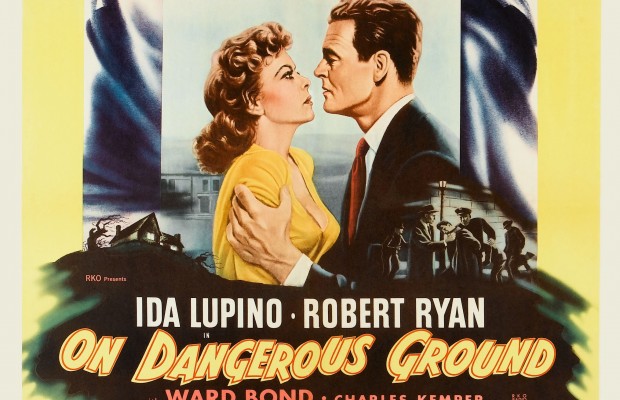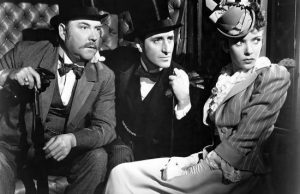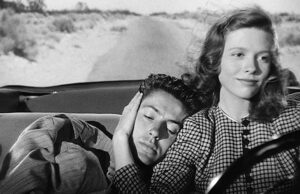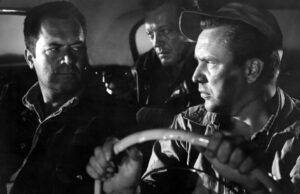On Dangerous Ground (1951)

Toronto Film Society presented On Dangerous Ground (1951) on Monday, November 5, 1973 in a double bill with The Bad and the Beautiful as part of the Season 26 Monday Evening Film Buff Series, Programme 1.
Production Company: R.K.O.-Radio. Dierctor: Nicholas Ray. Producer: John Houseman. Script: A.I. Bezzerides, based on a novel by Gerald Butler. Photography: George E. Diskant. Editor: Roland Gross. Art Directors: Albert D’Agostino, Ralph Berger. Music: Bernard Herrmann. Musical Director: C. Bakaleinikoff.
Cast: Robert Ryan (Jim Wilson), Ida Lupino (Mary Walden), Ward Bond (Walter Brent), Charles Kemper (Bill Daly), Anthony Ross (Pete Santos), Ed Begley (Captain Brawley), Ian Wolfe (Carrey), Sumner Williams (Danny Walden), Gus Schilling (Lucky).
Nicholas Ray was 36 when he made his remarkable first feature They Live By Night in 1949. During the next decade he may 20 films in Hollywood and abroad, films that combine a deep concern for social problems with the striking visual style–“indisputable records of a very personal anguish” [Andrew Sarris]. Ray feels his best film is Rebel Without a Cause. His capacity for self-criticism and appraisal is unusual among directors. Talking about his own work he is concerned about what people think, concerned about clarity and the way an idea communicates itself on the screen, and equally concerned about the precise placing of a story and its degree of documentary truth. He emphasized that for weeks before making On Dangerous Ground he had driven out with police squad cars in the toughest district of Boston.
Ray’s people are insecure, unstable, scarred by their surroundings or carry within themselves the seeds of their own destruction. They are inflicted with the psychic ills of the 1950s [Jim Wilson’s disillusionment with mankind], and often bear outward signs of emotional isolation [Mary Waldens blindness]. Most of Ray’s films have an element of violence and there is no doubt violence fascinates him as the unpredictable factor in human personality. On Dangerous Ground is an attempt to link two kinds of violence–the brutality of the hard-city cop confronted with the raw winter countryside which is the murder scene.
Though Ray’s interest and sympathy have been more often with the prey, the hero of On Dangerous Ground, Jim Wilson, is a predator. Ray has described him as “a man whose job is that of a member of the violence squad whose job is to apprehend or to prevent violence and yet who has that same violence within him”. The opening of the film is constructed to demonstrate Wilson’s isolation. The members of the police anti-violence team are all shown in their domestic context before going out on parole. Pete’s wife straps on his pistol, kisses him, and says how she hates being left alone; Bill is surrounded by a brood of children; but Wilson is alone, studying pictures of wanted criminals as he eats his meal. It is made clear that in many ways Wilson is a model policeman, but his capacity for violence becomes apparent when his colleagues have to restrain him from assaulting a citizen. To cool of the situation resulting from his beating up of a suspect, Wilson is sent from the city to a remote part of the state to assist in the detection of a murderer. Ray shows the journey by a series of tracking shot from the front seat of a car, each shot dissolving into the next to give a cumulative effect of remoteness and placidity in marked contrast to the previous scenes in the city. As is true of other Ray heroes, Wilson’s return to nature is an occasion for his increased self-knowledge and implied salvation. It emerges that the murderer is a half-witted boy, Danny Walden, and after two hunting scenes of enormous excitement and brutality [achieved by the animal imagery of Danny leaping from a tree, his pursuers following his tracks in the snow, and the violent insistence of Bernard Herrmann’s score] he’s tracked to a house where he lives with his blind sister. Mary is saved from the total isolation of Jim Wilson by her devotion to and care of her brother. Their situation is presented as idyllic, the name Walden recalls Thoreau’s natural paradise, and Mary even has a tree in her living-room. The metaphor of Danny as prey, implied in the stalking sequences, becomes more explicit and his animal-like movements, he’s whimpering, and in the den he has made for himself full of wood-carvings of animals. The Waldon’s world has a humanizing effect on Wilson and he conquers the violence within himself by trying to contain the violence in another. After Danny’s death, Mary’s new isolation and lack of purpose is indicated by her knocking over and breaking the objects in her living-room.
After a ten-year absence from the screen, Nicholas raise latest film we can’t go home again was shown at Collins last summer.
NOTE: John Houseman is the Producer for both of to-night’s films.
Notes compiled by Aideen Whitten
Sources: Sight & Sound – Autumn 1961, Underworld USA by Colin McArthur














Leave a Reply